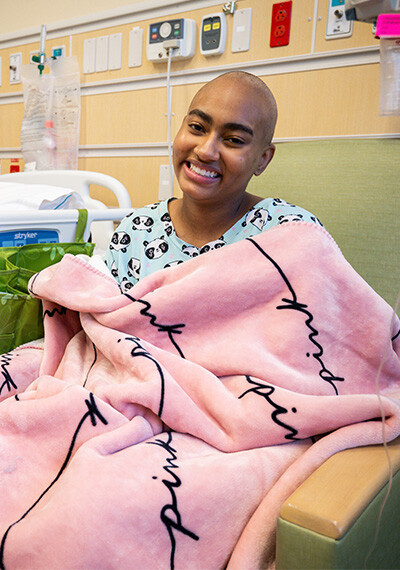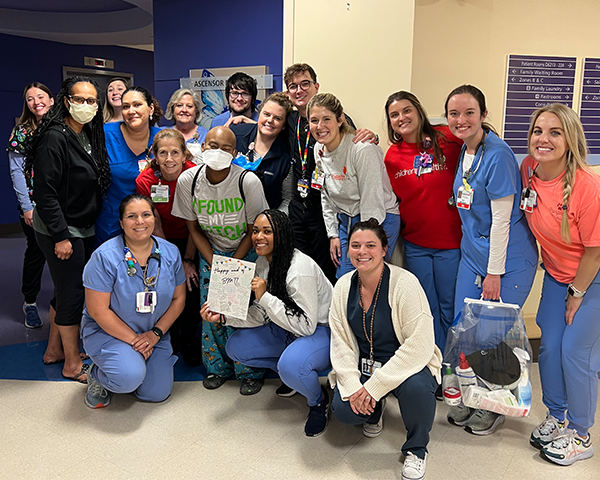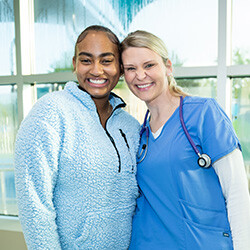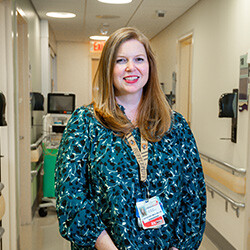
Alexis' Story: When her leukemia returned, her brother stepped in with her last hope for a cure
When her leukemia returned, Alexis' brother stepped in with her last hope for a cure.
DIAGNOSIS: Leukemia

Alexis and her mom waited all day for the tiny pouch of liquid gold.
The precious cargo of stem cells donated earlier that day in April by Alexis’ 12-year-old brother arrived in a cooler. And it was Alexis’ last hope.
Clinicians call it a bone marrow transplant, but this isn’t like an organ transplant. A week prior, Alexis, 18, was admitted to Children’s HealthSM and given an intensive round of chemotherapy to wipe out her immune system, clearing it to the point that even vaccines she received as a baby were no longer effective.
On the morning of transplant day, two Coke-liter bottles worth of bone marrow stem cells were collected with a syringe from her brother Aiden’s hip while he was sedated.
Alexis’ family anxiously waited for hours while an offsite lab prepared the stem cells. Her mom, Shannon, dressed up in a funny inflatable unicorn outfit and waddled down hospital hallways of the Dallas campus to pass the time and make her children laugh.
And just before dinner, her brother’s life-saving gift arrived and was admitted through an I.V., while Shannon held Alexis’ hand and quietly said a prayer.
I’m glad and blessed that I have my brother to give me his bone marrow. I hope and pray that my body will accept it. We’ll just have to wait and see.
— Alexis said the week before her transplant
An unexpected call
Two years earlier, Shannon received a call at 10 p.m. while she was getting ready for bed telling her that clinicians expected her then-15-year-old Alexis had leukemia.

The call was jarring.
Alexis had no symptoms of a serious illness. She’d gone in for routine bloodwork, when her endocrinologist discovered some abnormalities and sent them to Children’s Medical Center Dallas for further testing, which confirmed a diagnosis of acute myeloid leukemia.
“And that’s where our journey began. You could say that Children’s Health found me,” said Shannon, a mother of four who works in human resources and manages a college recruiting program. “We arrived that night and ended up staying for five months. Alexis understood that she was going to lose her hair, and as a teenage girl, that scared her.”
While Alexis was initially diagnosed at the Dallas campus, the family lives in Frisco, and she was later transferred to Children’s Medical Center Plano for most of her treatment. The move allowed Alexis to still receive the same quality care but closer to home, meaning friends and family could easily visit and Shannon could toggle between home and the hospital.
In 2021, the same year Alexis was admitted, an eight-story tower expansion of the Plano campus was launched – largely thanks to widespread philanthropic support. Alexis and Shannon have watched it rise up from their hospital room window. Once completed (possibly next year), the tower will allow team members to care for more kids like Alexis who live north of Dallas through enhanced program support and new technology.
“We’ve watched the evolution of the building for the last couple years. It’s exciting that they’re bringing more medical resources further north, especially as more and more people move to this area,” Shannon said.
The expansion of care is important because it will allow team members at Children’s Health to meet evolving patient needs for kids like Alexis as more families settle down in Collin County. These are team members who have stood by Alexis’ side for months and were her literal cheering squad as she rang the bell signaling the end of her treatment before her 16th birthday.
When I first found out that I had leukemia, it was really heartbreaking, but I really enjoyed being in the hospital with the nurses. They made life fun, and it made me feel like my friends were right there with me.
— Alexis
Alexis – who is manager of her high school girls' basketball team and whose cell number is saved in the coach’s phone as “boss” – made plans to attend college and study finance. She spent time with friends and family. She travelled and ate a lot of really great food.
“We’re very much a planning family, and it reminded us that you can’t plan for anything because anything can change,” Shannon said. “Everything was really good for a period of time.”
Aiden to the rescue
In the winter of 2022, Alexis began to notice more bruises on her body. Worried, she shared this observation with Shannon. And a week before Christmas, the family learned that her leukemia had relapsed.

“Getting diagnosed a second time was really hard for me. It’s my senior year, and I was looking forward to prom and my high school graduation,” Alexis said. “The experience has made me grateful for the things in life that I do have.”
Alexis was readmitted to the Plano campus at the beginning of the year to begin chemotherapy treatment for a second time. But this time, once the treatment was finished, she also would need a bone marrow transplant in the hope of curing her leukemia.
“Acute myeloid leukemia can be a little bit hard to treat. It’s one of the cancers that we say is a little pesky because it isn’t always a straight arrow,” said Tamra Slone, MD, who has cared for Alexis for several years and is a Pediatric Hematologist/Oncologist and Plano Service Chief in the Pauline Allen Gill Center for Cancer and Blood Disorders at Children’s Health.
A leader in patient care, treatment, research and training in pediatric oncology and hematology, the Gill Center brings national and international expertise through its affiliation with UT Southwestern and the Harold C. Simmons Cancer Center, setting it apart from other sites for pediatric cancer care in the region.
From common blood disorders to the rarest forms of cancer, the Gill Center continues to offer comprehensive evaluations, innovative treatments, long-term care and access to the latest clinical trials.
“Telling a patient that their cancer has returned is a hard conversation,” said Dr. Slone, also an Associate Professor at UT Southwestern Medical Center. “Alexis had gotten her ‘normal’ life back and was looking forward to her last year of high school. And she knew that this time, we would have to be even more intensive with the treatment.”
Immediately, Alexis’ medical team began the search for a bone marrow donor. Luckily, Alexis had two perfect matches – an older sister and her younger brother, Aiden.
Physicians decided Aiden was the best match, and a transplant date was set for mid-April.
“When Alexis’ leukemia returned, I was really sad because I didn’t want anything to happen to her. I wanted her to be OK,” Aiden said. “I told my mom that, yes, I would like to save my sister’s life, and she gave me a big hug.”

Isolated but not alone
Alexis wore a flowy blue prom dress under her navy cap and gown, complete with comfy, fuzzy socks and an IV pole in the background.
Her two older sisters had helped her with her hair and makeup, and a small group of administrators from Frisco ISD surprised her with a high school graduation ceremony in a family lounge area at Children’s Health.
Several weeks had passed since her bone marrow transplant, and she’d had to remain on an isolated unit at the Children’s Health Dallas campus – standard treatment for patients after transplant because they are immunocompromised.
And since this meant she had to miss the milestone of walking across the stage to receive her high school diploma, her care team at Children’s Health worked to bring the experience to her.
“People talk about giving money to hospitals they hear about on TV, and I want people to understand that supporting your local hospital is important. To me, Children’s Health is the best hospital in the United States. The team here has been with us every step of this journey, in big and small ways,” Shannon said. “You want to give to a place that supports the community, and Children’s Health does a great job of making sure that all children are taken care of.”
Over Facetime, her principal presented Alexis with the Perseverance Award, which she was nominated for by her classmates, and recognized Alexis as an inspiration for positivity in the face of adversity. Alexis was then presented with her diploma and officially honored as a graduate of the Class of 2023.
“We’re so proud of you, Alexis. It makes my heart full as a principal to honor you in this way. You are the embodiment of everything we want our students to be,” Principal Keith Tolleson said. “This is an extraordinary day for an extraordinary human being.”
Family and school officials clad in paper gowns, gloves and masks cheered, as Alexis beamed.
Her family knew that a bone marrow transplant would be hard – physically and mentally – but the last few weeks had been much harder than they imagined. For two months, Alexis and Shannon shared a room at Children’s Health. On good days, they attempted TikTok dances, and Shannon made laps around the hospital to give Alexis a break.

On tougher days, Alexis spent weeks in bed with the lights out. To pass the time, she built figurines from LEGO toy bricks. She talked with nurses and Child Life specialists about the foods she was looking forward to eating again one day, shopping and the future. She played card games with team members.
And she counted down the days until she could go home.
June 2nd was the day.
And for a second time, Alexis left Children’s Health to a cheering squad of nurses.
“Everyone loves Alexis,” she said, grinning.
We tracked down 5 team members, whose faces represent the web of support surrounding Alexis at Children’s Health.
Alexis calls the nurses, doctors and therapists who have cared for her the last couple of years her best friends.
They distracted the now-18-year-old with jokes and detailed conversations about how they preferred their burgers from In-N-Out, when she was undergoing chemotherapy at Children’s Medical Center Plano.
After her cancer relapsed last December, they listened to music with her at her bedside and gossiped about reality television, while she underwent a more intensive round of treatment to wipe her system from the cancer before receiving a bone marrow transplant from her younger brother this spring.
When she transferred in April to Children’s Medical Center Dallas for her transplant – spending months in isolation on the Bone Marrow Transplant unit with her mom, Shannon – they held her as she cried about missing her high school graduation and senior prom.
And when her discharge day came in June, they decorated signs and even came to work on their day off to cheer for her as she headed home.
These are their stories.

STEPHANIE CARADINE, RN, Gill Center for Cancer and Blood Disorders at Children’s Health Medical Center Plano
I truly believe laughter is the best medicine. That's always stuck in my head. So that's my goal – to get my kids to laugh or smile during my shift.
The first time I met Alexis, she was quiet and shy, but by my third shift, we were cutting up, laughing and pranking other nurses. Like, we’d hit the call light and order a cheeseburger and fries or something funny.
When I found out that Alexis had relapsed it really hurt because it was such a prime time for her with prom and graduation, but I was glad that I would get to be there for her and help her get through it again.
My favorite memory with Alexis is playing UNO with her on the night shift at the nurses’ station. We would tuck her mama in bed, and then she would come and hang out with us at the desk and play cards.
Donations make a difference because we're able to provide things for our patients that can help them forget they're in the hospital like toys, games, decorating their rooms and throwing them birthday parties. Those funds not only help us provide good care, but they help us let them be kids while they're in the hospital.

ANNIE EADS, RN, Gill Center for Cancer and Blood Disorders at Children’s Health Medical Center Plano
Growing up, I enjoyed babysitting younger kids. I loved the movie Patch Adams, specifically the scene when he wore the red clown nose in the hospital. And when I was 14, my dad passed away from cancer. It was through all those events that led me to become a pediatric oncology nurse. I knew I wanted to be the person at the bedside, in the hospital, with the red clown nose, making kids laugh.
With Alexis's family, I enjoyed being there, talking to them and giving them something to do to distract them from being in the hospital.
Some of the things I remember about Alexis are her smile and positive attitude.
I brought her mom and her a little charcuterie board tray one day, and they pulled out a bottle of sparkling grape juice, which cracked me up. They had all the little things to make it not feel like a hospital stay and make it fun.

KATHERINE SMALLING, Transplant Coordinator, Gill Center for Cancer and Blood Disorders at Children’s Medical Center Dallas
I help pediatric patients who have a diagnosis that requires them to get some kind of transplant. We do two types of transplants here. One is called an autologous transplant, where we take the patient's own stem cells, freeze them and then give them back after intense chemotherapy. The other one is where patients need a bone marrow transplant from a donor. Typically, those patients have a diagnosis where their bone marrow is either not making healthy cells, or it's not making enough cells. For those patients, I help identify a donor for them. Before I met Alexis, I started looking into whether she had any matches with her siblings. When I found out she and her brother were a match, I called her mom, who was thrilled that she had matched with one of her siblings.
At the time, Alexis was in-patient at Children’s Medical Center Plano, so I drove from our Dallas campus, where the transplant would take place, to meet with Alexis in-person. We spent a couple of hours talking with her and her mom about the process – what a bone marrow transplant would be like for her and what it would be like for her brother.
All CCBD populations are in critical need of care, but bone marrow transplant patients have an extra level of complication in their care, and I feel very privileged to be a part of that journey.

TIFFANY SIMMS-WALDRIP, M.D., Pediatric Hematologist/Oncologist and Clinical Director of Hematopoietic Stem Cell Transplant in the Gill Center for Cancer and Blood Disorders at Children’s Medical Center Dallas, Associate Professor at UT Southwestern Medical Center
When we first met Alexis and knew that she needed a transplant, the first step that we took was to check the siblings to see if we could find a brother or a sister who’s a potential match. Alexis was lucky in that she had both a brother and sister who were a perfect match for her. And ultimately, we chose the brother as the best match for Alexis.
Bone marrow transplant patients can become pretty ill. They don’t feel good. So, there are definitely lows, but there are also highs, too. One of the biggest high points for families and for patients is when you start to see on the labs that new cells are growing. That’s one of the biggest milestones families experience until it’s time to go home.
Bone marrow transplant is the only cure for a lot of diseases. It’s not an easy cure. It’s not something we take lightly or can be done easily. But for these patients that do qualify for a transplant, it gives them a chance to beat their leukemia.

DIAMOND WRIGHT, RN, Gill Center for Cancer and Blood Disorders, Children’s Medical Center Dallas
I always knew I wanted to work in hematology-oncology. I've had some family members that have struggled with cancer, and I felt like this was a good way to give back. When I met Alexis, she was at that point in her life when it was time for prom and graduation, and we had a lot in common – specifically food. We both like to watch cooking shows and eat. I wanted to support her because I knew she was missing out on spending time with her friends and big high school milestones. And it was important to me.
I even picked up an extra day on the day that I knew she was going to be discharged from the hospital, so I could tell her goodbye and cheer her on with the rest of the team. I felt like we had a journey together.
It felt so good to watch her walk through those doors because she worked so hard to go home, and there were so many barriers to her being able to leave.
Read more patient stories like Alexis' to learn how Children's Medical Center Foundation impacts the lives of North Texas children.
Kids count on us. We count on you.
Give to support innovative research, lifesaving treatments and compassionate care.
Did you enjoy this story?
If you would like to receive an email when new stories like this one are posted to our website, please complete the form below. We won't share your information, and you can unsubscribe any time.

